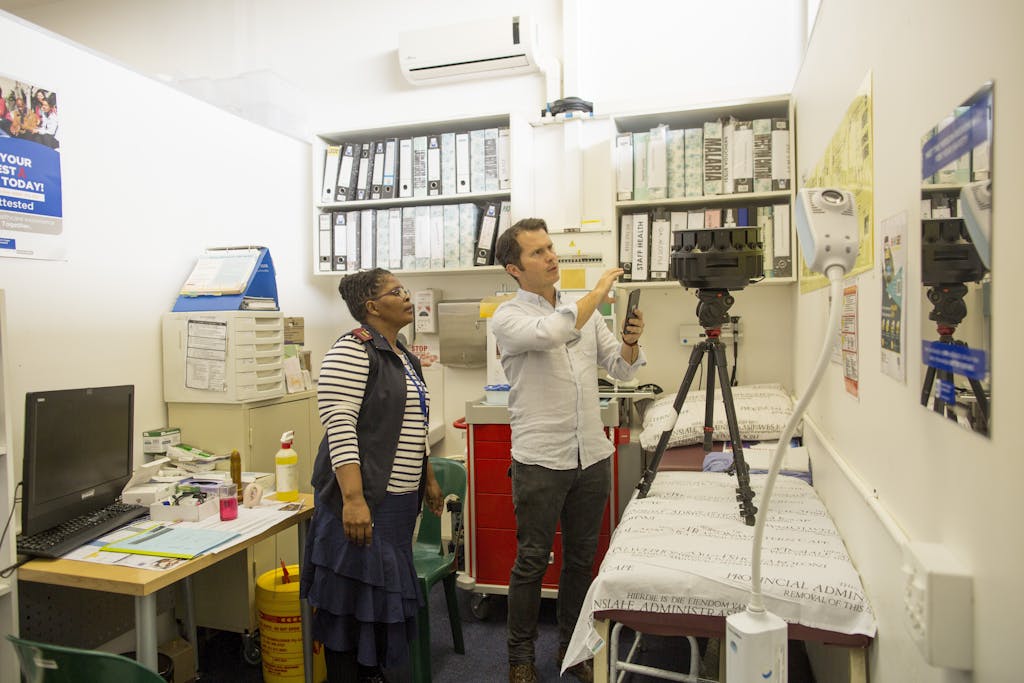“My name is Lihle, and I am a young person living with HIV. I am here to bring hope to those who are feeling lost. Remember, you are not alone,” says Lihle Bhebhe, a young woman featured in 360HIV, a virtual reality film launched by the Joint United Nations Programme on HIV/AIDS (UNAIDS) in 2018 to address a major obstacle in the AIDS response globally: The social stigma of living with HIV.
In the 360HIV films, Lihle takes us through her journey as a young person getting tested for, and diagnosed with, HIV. She meets with a nurse and a peer counselor, and builds a plan and support system so that she can continue to live a full life.
UNAIDS partnered with Google and Makhulu, a creative media agency in South Africa, to put viewers in the shoes of young people like Lihle living with HIV/AIDS and their health care workers. By being fully immersed in Lihle’s story, virtual reality viewers get a real sense of both the challenges young people with HIV face, but also the future they can create when they get testing and treatment.
This new approach to HIV/AIDS education seeks to not only raise awareness of the issue, but to encourage young people to get tested. Through an immersive VR experience, the films aim to break down stereotypes, make testing more accessible, and assist broader efforts by the United Nations and partners to achieve Sustainable Development Goal 3 – ensuring healthy lives and promoting well-being for all at all ages.
Why Young People Aren’t Getting Tested for HIV/AIDS
The first cases of AIDS were reported in South Africa in the early 1980s. Since then, it has become home to the largest HIV epidemic in the world. The government, civil society groups, and partners including the Global Fund to Fight AIDS, Tuberculosis and Malaria, the U.S. President’s Emergency Plan for AIDS Relief (PEPFAR), and UNAIDS have worked to fight back against the disease.
While HIV/AIDS is no longer a death sentence, patients first need to know their status in order to access lifesaving treatments and stop transmission. Unfortunately, there are many barriers preventing people from getting tested. Only 23% of girls and 17% of boys from the ages of 15 to 19 in eastern and southern Africa have undergone testing in the past 12 months, according to UNICEF. Experts say stigma is a main reason young people avoid getting tested.
One source of social stigma comes from an unexpected place: health workers. In a study conducted by the Desmond Tutu HIV Foundation, many young people said that they felt judged by clinic staff who lectured them on sexual morality and started rumors about a patient in the local community.
Cape Town health care worker Sister Nomtando Vece understands the damaging effect of such behavior. “Research has shown that stigma from nurses toward young people greatly affects their attitudes toward testing and treatment,” she said. “Young people have the right to sexual health care.”
Fighting Stigma Through Immersive Storytelling
Since the first case of AIDS was reported in South Africa, organizations have launched dozens of mass media campaigns to address the epidemic, many of which have inadvertently ended up perpetuating stigma instead of reducing it by incorporating prejudices around race, sexuality, and morality.

Recognizing the issues of the past, many organizations today are looking to address awareness and prevention campaigns in a new way.
The media company Makhulu joined forces with UNAIDS, Google, and local non-profits — including Youth Voices, the Desmond Tutu HIV Foundation, and the Children’s Radio Foundation — to launch the 360HIV partnership and produce a series of virtual reality films with the goal of changing behavior around HIV testing among youth.
The films focus on two real-life stories: One on Lihle’s experience as she goes through the process of testing and care and one on Sister Vece’s work as a nurse and how she interacts with young patients.
By putting nurses in the shoes of Lilhe and by putting young patients in the position of Sister Vece, the 360HIV series hopes to use virtual reality to increase understanding between the two communities. Understanding, they hope, will lead to behavior change.
The films debuted last year at clinics in five different towns near Cape Town. Young people and clinic staff watched the films on headsets provided by Google and then shared their responses.
The results were promising. Before viewing the VR film, 63.3% of clinic workers answered that they would privately speak to their colleagues after they observed them speaking harshly to a young person during HIV testing. After watching the VR film, 93.1% felt more likely to intervene. A nurse in the focus group reflected that after watching the film, she asked herself if she ever poorly treated a patient. She said the film reminded her that she is dealing with people’s lives and must remember to offer the best care she can provide.

The study also found that the virtual reality platform, which focuses on one individual’s perspective and blocks out distractions, left a more lasting imprint of the campaign’s overall messaging than traditional 2D films.
Following this initial study, the 360HIV partnership is hoping to roll out the film to more clinics across South Africa and launch a longer-term study to better understand the effects of virtual reality technology on stigma. Eventually, they hope to get VR sets into the hands of more employees and young people at clinics, so more people can have access to the technology.
For her part, Sister Vece ends her video with a dream for the future, one that the UNAIDS team and the 360HIV partnership are working together to achieve: “Imagine if everyone working at the health facility treated all young people with respect. Imagine that staff were aware of their actions and treated young people sensitively. Imagine they were given the best advice in a kind and respectful manner; without judgment.”
A world like this could mean more young people like Lilhe getting the care they need and deserve.
Want to learn more about how the UN is innovating to improve lives? Sign up to be a champion of innovation.
Innovation in Action shares the stories of how the UN is working with partners to pilot, test, and scale new ideas and new ways of working to deliver better results for people on the ground. From using artificial intelligence to better understand peoples’ needs to innovative methods to reduce maternal and infant mortality to reimagined partnerships and new approaches to mediation, the UN is working across issues and sectors to create dynamic and impactful solutions. The series has been developed with input and support from the UN, including the UN Innovation Network.
Thank you to UNAIDS and Rowan Pybus and Sydelle Willow Smith of Makhulu for sharing this story.



 View All Blog Posts
View All Blog Posts

